In the early afternoon haze and post-Sterling Brunch lethargy, I find myself leaning back against the darkness of a Baltimore Museum of Art (BMA) side room.
Before me rises Kevin Beasley’s immense installation Chair of the Ministers of Defense, a sculptural piece of resin-stiffened hoods made of various clothing materials looming over a single wicker chair.
The rounded fabrics also frame a metal window, through which a yellow center fades to orange. Meanwhile, black feathers scatter, suspended.
A spot of light illuminates the work, and the rest of the room scurries to blackness.
The empty shells, where bodies should could and would — be, gaze down to the floor, their color drawing the eye into their mass and along their siteline.
This piece is the final stop in the BMA limited exhibit Generations: A History of Black Abstract Art, which will reside in the building until Jan. 19, 2020.
Upon entering, I had set aside precisely an hour of my time. However, I ended up wandering the exhibit for nearly twice that, caught by the sheer breadth and information as well as the varied and intense artistry on display.
The collection seeks to give a comprehensive and diverse understanding of the response by black artists to the abstract artistic movement, the history of which they have largely been excluded from.
The post-World War II inclination to paint outside the established conventions of the Western artistic practice and test form as content was widely supported and explored by black artists.
Recognition, however, remained elusive in an art world that often viewed art created by someone who experienced a marginalized identity as solely a representation of that identifying experience. Thus the need for this kind of an exhibit was clear.
The work in the show ranges from just shy of representational to the more classically abstract.
Lynette Yiadom-Boakye’s collection of oil paintings depict individual black figures in an abstract, timeless space or Charles Gaines’ Numbers and Trees: Central Park Series IV: Tree #9, in which trees have been reduced and rebuilt using a colorized mathematical and spatial system.
Meanwhile, Mark Bradford’s My Grandmother Felt the Color abstracts the city grid of Los Angeles to represent both the macro and the minute cosmos, and Alma Thomas’ Evening Glow explores color pattern and theory in connection to nature.
Form, while difficult to pinpoint, also varies, from sculpture to digital image, from woodwork to paint and from mosaic to installation.
In addition, the work spans from the 1940s to the present day and displays a breadth of work from 28 distinct artists.
While much of the exhibit is separated into a gallery format with small excerpts from each artist, there are substantial sections of two artists whose works interact with one another, such as Jack Whittens and Sam Gilliard, whose use of color and form juxtapose with one another, or Melvin Edwards and Leonardo Drew, who have coordinated an intimate conversation between their respective works.
The detailed biographies and documented praise accompanying the pieces also worked well to provide both an artistically intimate report of personal context for the artist as well as context in regards to how the work interacted with the art world as a whole.
This was especially necessary for an exhibit that covered ground museums rarely set foot on.
The exhibit ends with Beasley’s final installation. In a gallery teeming with content and variety, I appreciated the cool darkness and meditative focus of the final room.
The patterns are overwhelming, smoothing the integrating the last few hours into my mind.
Even now, I want to return, to spend more time with the pieces, stand in their conversation, observe and read and observe again.
There was such intentionality, so many ideas and forms and colors. I would highly recommend reserving a few hours over the next few weeks to view it for yourself.
You can also reserve time slots on the BMA website and tickets are $10 (free if you’re a member). There are also free days Oct. 26-27 and Nov. 23-24. Maybe I’ll see you there.





